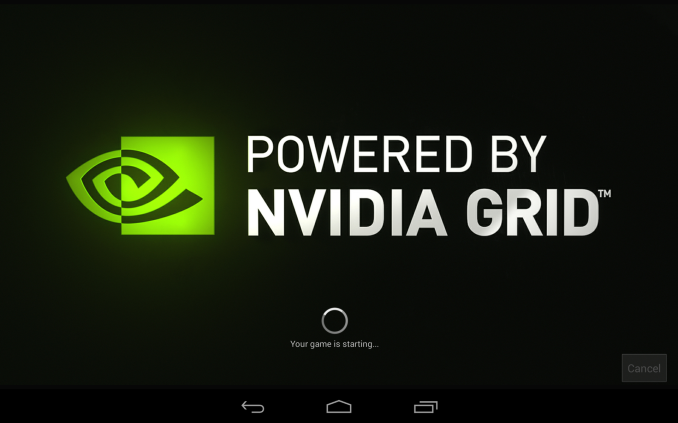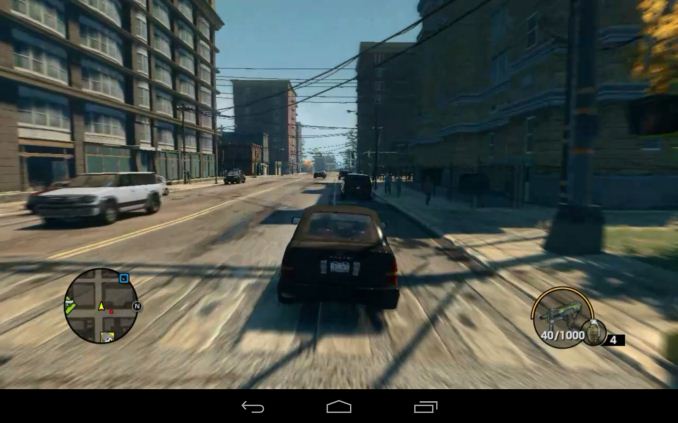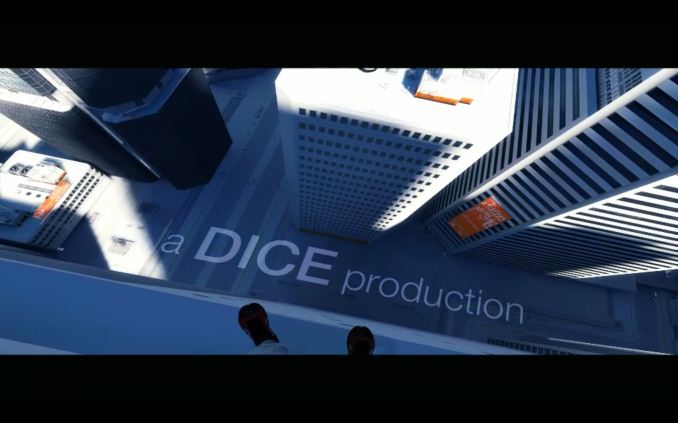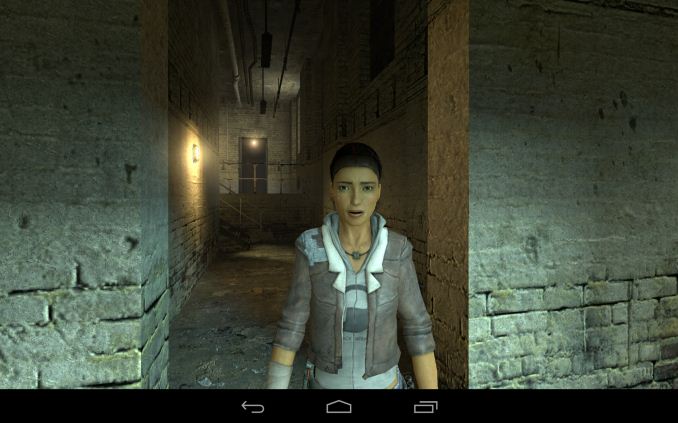The NVIDIA SHIELD Tablet Review
by Joshua Ho on July 29, 2014 9:00 AM ESTGameStream and GRID
The final software features that Shield Tablet brings to the table are GameStream and GRID. These are effectively methods of turning the tablet into a thin client, as all of the rendering/computation is done on a computer either in the LAN or on a server in San Jose. From a technical perspective, both work great as long as the connection has high bandwidth and low latency. For GRID, I managed to get a great user experience on a symmetrical 10 Mbps connection and around 10ms latency to the server. Games like Saints Row 3 played as if running on a console when the device is actually streaming from NVIDIA servers. From the user’s perspective, it’s a matter of going into the app drawer, opening GRID, and selecting a game. It’s simple and given sufficient server coverage I could easily see a Netflix-style usage model taking off quite successfully.
Although I didn’t spend as much time with GameStream, I didn’t detect any input lag and for the most part it’s just as simple. As long as a GameStream-enabled PC is on the same network, accessing GameStream compatible games is just a matter of going to the Shield Hub application, entering a four digit code on the PC to pair it with the tablet, and selecting a game. GameStream also works remotely, but the same caveats that come with GRID apply to GameStream on both the server and client end. Of course, the games that will run on GameStream have to be carefully selected. While it’s fully possible to play a twitch shooter like Call of Duty through GameStream, trying to use a controller in multiplayer is simply a massive disadvantage against people that are competent with a mouse and keyboard. I've included a screenshot of Mirror's Edge that I took while testing GameStream.
Gaming Ecosystem
Ultimately, I’m a bit conflicted on whether GameStream and GRID are really designed to stand on their own though. GameStream only works while you’re at home, and GRID is highly dependent upon low latency and also needs around 10 Mbps download and 5 Mbps upload for an ideal experience. Due to the latency requirement and the fact that the only GRID server bank is in San Jose, the very low latencies that GRID is best suited for are generally only achievable in California and parts of other nearby states. They’re definitely great in the situations that they work, but ultimately the native game library has to stand alone. To this end, the tablet is in a far better situation than the original Shield. The number of games that provide a quality gaming experience is now leaps and bounds better than what we saw with the launch of the Shield Portable. Trine 2 is included out of the box, and while I didn’t get a chance to try co-op mode it’s a compelling experience that once needed GameStream or GRID to be played on Shield. Along the same lines, the Grand Theft Auto series, Half Life 2, and Portal all play surprisingly well.
Fundamentally though, I don’t think single player games alone will sell Shield as a gaming platform. A single player game can only have a certain amount of replay value. Something like Half Life 2 might have 12 hours of gameplay at best. In comparison, multiplayer has massive amounts of replay value because even the same map can play out differently depending upon the people that play in the round. It’s that factor that makes it possible for people to spend 1200 hours playing a game like Battlefield 2. Unfortunately, for the most part the Shield tablet has a game library that seems to be skewed towards single player games. Fortunately, NVIDIA seems to understand this. While I haven’t been able to play War Thunder on Shield tablet, the promise of compelling multiplayer games on this device would be a strong enough reason to excuse potential shortcomings in other areas. Although it's good that an immersive multiplayer title is coming to Shield tablet, the key point of emphasis is that people playing a Shield device can play with those on console or PC as well. Until NVIDIA hits critical mass for Shield device adoption, multiplayer titles that only allow people on Shield to play with others on Shield will struggle because people won't play multiplayer unless there are other people to play with.















174 Comments
View All Comments
sherlockwing - Tuesday, July 29, 2014 - link
If and only if you are color blind.Moizy - Tuesday, July 29, 2014 - link
Crappy? It's no iPad Air or Nexus 7, but it's still good. Read Josh's article from the other day where he went back to the archives and tested smartphone panels that were once awesome in their day. Just 3 years ago we were praising the contrast of SAMOLED and the great resolutions those phones had. The Shield Tablet is leaps and bounds ahead of them, in accuracy, gamut, and pixel density, and just a tier below the iPad Airs and Nexus 7s of the world. For $300 and all this tablet can do, I would highly recommend this tablet to most anyone, and still plan on getting one for work and graduate school.boozed - Tuesday, July 29, 2014 - link
After reading "crappy" I was expecting a much worse result than the reality expressed in the review, so that's an exaggeration.I wouldn't be surprised if this screen still outperforms the majority of desktop gaming monitors out of the box.
edlee - Tuesday, July 29, 2014 - link
this soc it a powerhouse, nvidia is stupid that they do not mass produce it for mass produced products from HTC and Samsung. They made tablet GPU that is faster than Intel HD4000, which is pretty significant.But Nvidia doesn't have enough brand cognition for the simple consumer to know this is a killer product, not sure why you dont hear more partners for this soc.
melgross - Tuesday, July 29, 2014 - link
They do, but few manufacturers seem to want their SoC's.johnny_boy - Tuesday, July 29, 2014 - link
I don't get why since they make a pretty damn compelling SoC. Sure, previous generations weren't very exciting, but those were previous generations!phoenix_rizzen - Tuesday, July 29, 2014 - link
Fool me once (Tegra1), shame on me.Fool me twice (Tegra2), shame on you.
Fool me thrice (Tegra3), screw you!
Fool me a fourth time (Tegra4), I'll never listen to you again.
After all the hypocrisy and broken promises and what not from nVidia from the previous generations, is it really any wonder that no one wants to trust them again? All the big phone/tablet manufacturers are going to sit out this round and let nVidia go it alone. Maybe some smaller vendors will nibble at the line, and maybe some of them will have some successes with Tegra K1. But you won't see any major vendors using Tegra K1 until it proves itself in the market.
If nVidia hadn't burned so many bridges with Tegras 1-3 they'd be in a better position to take on Qualcomm, Samsung, ARM, and Intel. But, even with how good this SoC may be, it's still too little, too late.
Don't screw over your customers if you want them to be repeat customers!
TheJian - Wednesday, July 30, 2014 - link
You're mistaken. It was the only thing at google IO. In their automotive, their developer device (tango), TV, and it seems nexus tablet coming for gamers (9in IIRC).Too little too late? ROFL. It dominated the 805 and everything else here. Right on time is more like it. It will be in Google's Nov HTC Nexus 9 tablet at least. Mipad from xaiomi, Lenovo Thinkvision AIO 28, of course Jetson dev board also. I'm guessing A shield R2 coming shortly too with 1440x810 as the other specs that floated around showed (which clearly isn't this tablet, and it supposedly has 4GB ram, so again not this device). Small volumes right now probably prevent a dual launch of both shield products or they may wait for Denver since there is already quite a bit of interested parties using it as noted. If all you can produce goes to the above mentioned devices shield 2 may have to wait a bit.
akdj - Sunday, August 3, 2014 - link
Unfortunately, when ya want the 'power'. The promise of the 'performance'. And probably most importantly in today's mass market, it's 'efficiency'. Sure, they're flat hauling ASS in these benchmarks @ full tilt but a couple hours off the wall and you're done (with a AAA game that's the main draw to this tablet, right? --- I can't imagine the 'power' browser, or super reader or the 'AA' games I'm enjoying , Dark Room, The Room. Sometimes ya die. Maybe some car racing and if I've got the time an RPG FPS or an MMO, it's rare. In fact with my nine year old son it's 'his' time on my iDevices playing the games, the AA games that kick incredible ass but aren't AAA because they're not in a computer, console or dedicated gaming system. Laughable. I'm 43 and Ultima, Myst and Diablo A & B. Not the latest. Those were my games. Ultima online, I don't have the time nor do most 'tablet clients'. This is a niche product and an SoC with extreme limitations if you're taxing it's power. Obviously, using it as a movie watching, media browsing and light productivity....it's amazing efficiency. But, argument of color aside....we are moving to a HiDPI world with excellent color production on phones, tablets computers and TVs/4k, et al. If the screen is subjectively by the author after objective measurements confirming it.... 'Washed out' sounds lame. So does a pair of hours if I want to game a bit while on a three plus hour flight. A8 from Apple, Quallcomm NAND their 64bit architecture, significantly deeper libraries of apps, games and general interest software, Apple and Samsung, nor Google or ASUS, HTC LG or ABC going to take this risk again and it's exactly that. A speed demon you're unable to take advantage of if you're away for a charger. And a tablet plugged in = a major PITA. SoCs have to strike a balance. And with Metal/A8/Continuity and Google's response to come. Samsung's readying the new Note 4. Possible 805? With the 420, it'll fly through a helluva lot of games. And it's display is going to best the best today. The S5 from the same family. AMOLED has come a long way. IPS display with 'washed out' colors isn't appealing.akdj - Sunday, August 3, 2014 - link
No edit. Wasn't supposed to be Quallcom's NAND. Rather Qualcomm and their 64 bit response to second generation 64bit A8. Cool and exciting to have the completion but yeah, burned three times it was tough to trust a fourth gen to leave the shelf without the reliability of ARM, Snapdragon and the 'A' series Apple tweaked ARM SoCs. Both dedicated AND delivering with incredible improvements. Look at Note 1-->Note 3's benches. iPhone 4-->5s. Two years and mind bending speed, efficiency and even more software ('apps') then before with more possibilities. Intel now in w/BayTrail, I'm wishing nVidia the best. I'm a fan